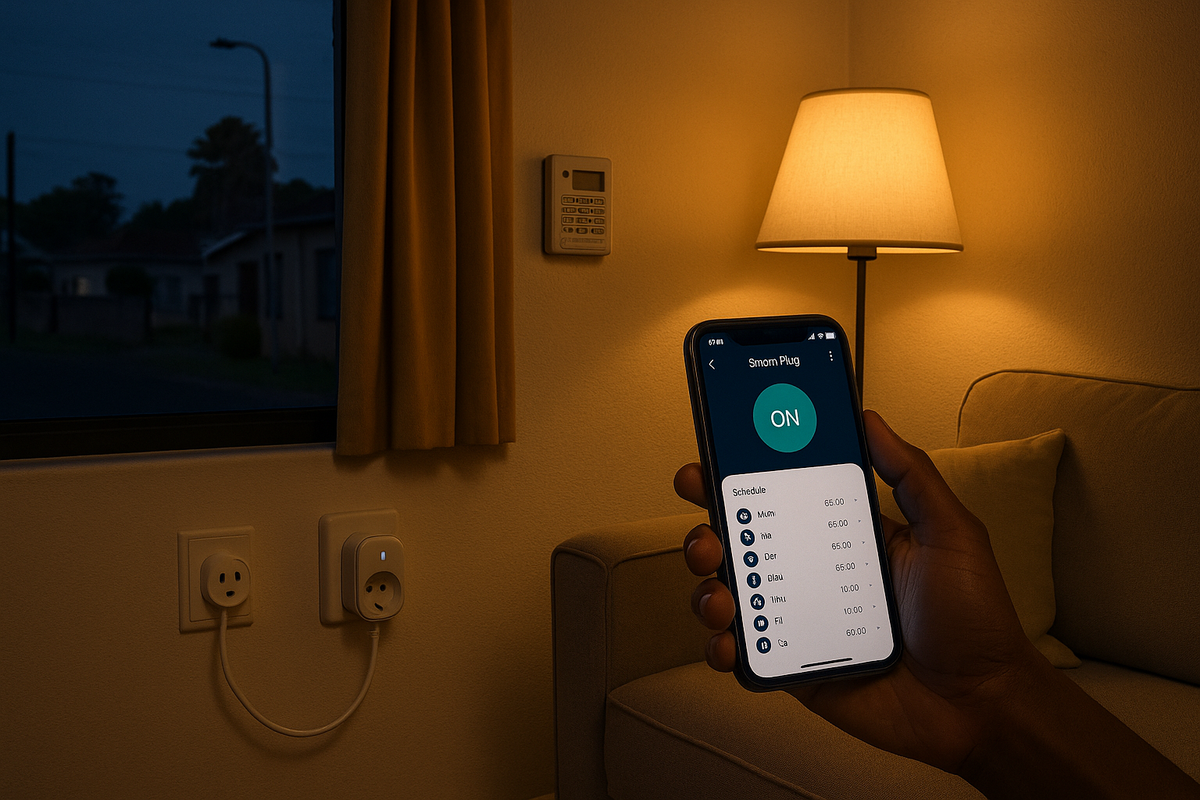🎥Smart sockets & plugs for the South African home to save on tariffs and boost convenience
Load-shedding may come and go, yet electricity costs keep drifting upward. Smart plugs offer a practical response that could help.

🔴 Have you read these articles yet?
👉 New Honor X7d hit the market at ~R4,000. Is it worth it?
👉 FSCA-licensed or no-go? A pocket guide to South Africa’s CASP regime
South Africans know the drill already: higher Eskom tariffs, surprise prepaid jumps, and a constant scramble to stay online for work and side hustles. You might already be juggling SIM cards and portable Wi-Fi back-up options when fibre debit orders look dangerous.
Many households also shore things up with budget power banks that keep phones alive through taxi rides and evening load-shedding. Smart sockets and plugs slot into that same survival kit: small bits of hardware that help you dodge peak tariffs, cut wasted kilowatt-hours, and still live a normal life with lights, routers, and heaters that behave themselves.

Why tariffs are suddenly everyone’s problem
Eskom’s average tariffs are increasing again, with the national energy regulator approving a 12.7% hike for the 2025/26 financial year, after years of above-inflation increases already baked into household budgets. At the same time, more municipalities are rolling out time-of-use tariffs that charge different rates for peak, standard, and off-peak hours, based on demand.
Peak hours in South Africa usually fall around breakfast and supper, roughly 06 am to 09 am and 7 pm to 9 pm, although exact windows vary by city and season. Those are the moments when geysers, heaters, stoves, kettles, and streaming screens all fight for the same expensive electrons.
Time-of-use pricing is not only a punishment scheme. The regulator expects ToU to lower costs for most households over the long haul, with national savings forecast in the tens of billions of rand and about 95% of users paying the same or less compared with flat tariffs, provided they shift enough usage out of peak windows. That “provided” is the catch. Shifting usage needs either discipline, automation, or both.
What smart plugs and sockets can do
Smart plugs are Wi-Fi-enabled adaptors that slot into a standard wall socket, then connect to your phone through an app. They let you turn appliances on or off remotely, schedule when devices receive power, and in many cases see exactly how much energy each gadget consumes.
Smart sockets are the built-in version. They replace a wall outlet entirely and often have higher current ratings, which suits heavy-duty appliances, although installation normally needs a qualified electrician.
Most mainstream options in South Africa support scheduling, energy monitoring, automation triggers, and voice control through platforms like Google Assistant and Alexa.
Smart sockets are not miracle gadgets. Used with realistic settings and the right tariff, they help households nudge power-hungry devices into cheaper time slots and expose the appliances that burn through units for nothing. Over weeks and months, that combination can make a noticeable dent in Eskom’s monthly bill without switching your lifestyle to full camping mode.
Where tariffs and smart plugs meet
Time-of-use tariffs pay off when you can move energy-intensive tasks out of peak periods and avoid “vampire” loads that sit on standby all day. Smart plugs do both.
A simple example: a 2 kW heater running for two hours during the evening peak draws 4 kWh. Under a ToU tariff, those same 4 kWh might cost significantly less if shifted to an off-peak slot later at night or early morning, depending on the municipal schedule. Smart sockets help enforce that behaviour even when you forget, by killing power on schedule.
Energy-monitoring models show live or historical data per appliance, so you can see that the old bar fridge in the garage quietly costs more than the new gaming console or that the tumble dryer you use “for ten minutes” after each wash is a monthly villain.
Smart-setup ideas for a South African home
You do not need a fully integrated smart-home system for smart plugs to help. A handful of adaptors, placed strategically, can align your consumption with your tariff.
1. Routers, ONTs, and work gear
Keep the router, ONT, and maybe a small desk lamp or monitor on a smart plug and mini-UPS combination. Schedule the plug to switch off at 01:00 and back on at 5 am if nobody needs overnight streaming. That avoids phantom loads pulling power through the UPS battery while the house sleeps, and you still wake up to Wi-Fi.
2. Heaters and panel heaters
Electric heaters chew through units, especially on winter evenings. Use a smart plug to create strict time blocks, for example, 6 pm to 8h30 pm and 05h30 am to 7 am, then hand over to thermal blankets or warmer clothing outside those windows. On a ToU tariff, push as much heating as possible into standard or off-peak periods while keeping rooms tolerable during peak times.
3. Washing machines and dishwashers
Many modern machines already support delayed start. Pairing them with smart plugs lets you stack control: the machine delay plus a plug schedule. Set the cycle to complete during late-night off-peak tariffs so everything is clean by morning without paying peak rates.
Smart plugs shine on unglamorous tasks. Laundry, routers, dishwashers, geyser boosters, and panel heaters do not need manual babysitting every evening. Once schedules match your tariff, the app becomes less of a toy and more of a quiet accountant, cutting off power in the background with zero debate.
4. TVs, consoles, and streaming boxes
Modern entertainment gear draws power even when “off”. A smart plug can cut the supply completely after midnight or once your phone disconnects from the TV’s casting app. In apartments with thin walls, schedule power-down earlier on weeknights and later on weekends so late-night gaming does not turn into a neighbour complaint marathon.
What to look for when you buy
The South African market is oversaturated with Wi-Fi plugs and sockets at wildly different price points. A few checks matter more than smart-home gimmicks.
Check the current rating
Standard three-pin plugs on local circuits are rated 16 A at 230 V, which translates to about 3.6 kW. Many budget smart plugs top out at 10 or 13 A, meaning they are safer for TVs, routers, lamps, and charging gear than for kettles or big heaters. Always match the plug’s rating to the appliance label and avoid chaining multiplugs or extension leads off one smart adaptor.
Stick to established brands and local distributors
Repeating social-media ads promise “energy-saving miracle plugs” that claim to cut your bill without changing habits. Consumer testing in other markets found that many of these devices deliver no measurable savings and sometimes fail basic safety checks, with fire risks flagged in several cases. Buy from reputable local retailers or installers where devices comply with South African safety standards.
Prioritise energy data and scheduling over novelty tricks
Features that meaningfully help with tariffs include accurate consumption tracking, configurable schedules, and support for multiple profiles. Trend graphs and exportable logs make it easier to see whether recent tariff hikes match your usage or reveal a problem appliance.
Think about tenants and home-owners differently
Renters often cannot replace geyser timers or install new wall sockets. Plug-in adaptors still provide control over entertainment setups, home office corners, and portable heating. Home-owners with access to the distribution board can combine smart sockets, smart relays for geysers, and even solar inverters or smart controllers to automate entire circuits rather than single devices.
Tariffs, smart plugs, and millennial sanity
Electricity will not get cheaper in South Africa any time soon, and ToU tariffs are unlikely to disappear. Smart plugs and sockets cannot erase Eskom’s history or fix municipal finances, although they help you respond with data rather than guesswork.
A modest starter pack of three or four plugs, used on the worst offenders in a household, can reveal where tariffs bite hardest, which devices deserve prime-time access, and which ones belong on late-night off-peak schedules. Combined with sensible upgrades like UPS units, efficient heaters, and better insulation, they form part of a broader strategy: fewer nasty surprises on prepaid balances and more predictability in the month-end budget.
Smart sockets are less about following another gadget trend and more about gaining small slices of control over a system that tends to ignore ordinary users. In a country where a single tariff increase can wipe out the breathing room in a South African's paycheque, control is crucial.
🔴👉 Visit our Categories page to find your favourite read!
🔴👉Visit our other publications
The Travel Thread | Where lekker meets latitude.
Karoo Times | Real Karoo. Real People. Real Business.
De Kaap Echo | Your community. Your story.




Comments ()